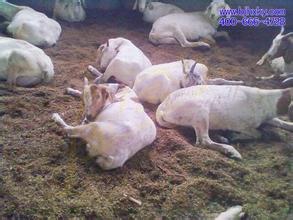Sheep lice infection is a common parasitic disease in sheep farms. Sheath liceosis is caused by parasitism in the small intestine by monnitids, trichomoniasis, and amygdalin. Among them, Monitis aphid is most severely harmed and commonly found in lambs. It not only affects the growth and development of sheep, but also causes the death of sheep. The use of goldfish fermentation bed sheep (for details, please click) can prevent the incidence and transmission of sheep ascariasis.

Affected sheep showed poor energy, loss of appetite, like drinking water, often accompanied by diarrhea, sometimes constipation and diarrhea alternately occur, while the feces are mixed with milky white eggs. After the lamb is infected, it quickly loses weight, gets rough hair and loses its luster. Checking the fresh feces of diseased sheep in the early morning can be found on the surface of the feces. The body's secretions and metabolites can cause neurotoxicity in the sheep, manifested as a circling movement, or convulsions, excitement, and collision.
If the sheep is only sick, you can treat it as follows:
1.1% copper sulfate has a good insect repellent effect on sheep ticks.
Generally lambs can be given 15-45 ml for 1-6 months, and 45-100 ml for 7 months for adult lambs. The cure rate is about 80%. Refill once every 2-3 weeks. The drug requires pure product. It is prepared on the same day and used on the same day. It cannot stay overnight. ?
2. The arsenic trioxide, stannous arsenate and calcium arsenate can be used to deter insects.The doses were: 0.5 g of lamb, 1 g of adult sheep, and one dose of service. Give oil laxative after medication.
3. Benzominazole 8-10 mg/kg body weight, albendazole 10-15 mg/kg body weight, and niclosamide 80-100 mg/kg body weight may also be used.The disease can be actively prevented from reducing losses. Regular deworming, good management of feces, killing the mantle, places where conditions can be deep-turned land or with the odd-footed animals, animal husbandry, usually two years apart from the positive ground to death. Do not grazing in the early morning or early evening, do not feed dewy grass, and prevent deworming of previously affected sheep before entering the new pasture. The use of gems in a dry-sweeping broth bed to decompose the feces and kill eggs can greatly reduce the risk of herpes zosterosis in herds. Details can be consulted: Beijing Huaxia Kangyuan Technology Co., Ltd. Telephone toll-free hotline Recommended reading:
Sheep foot rot disease factors and symptoms and control methods
The best choice for winter sheep
Laboratory Spectrophotometer,Spectrophotometer Principle,Lab Spectrophotometry,Flame Spectrophotometer For Lab
Guangdong Widinlsa International Co.Ltd , https://www.widinlsa.com